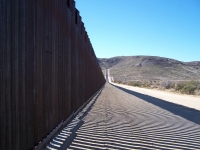 March 30, 2011 (Washington D.C.) Earlier this month, Congressman Duncan D. Hunter (R-El Cajon) introduced bipartisan legislation, the Unlawful Border Entry Prevention Act, which includes San Diego Congressman Brian Bilbray among its cosponsors. The measure would provide the Secretary of Homeland Security with full discretionary authority to build up to 350 miles of additional infrastructure on the Southwest border.
March 30, 2011 (Washington D.C.) Earlier this month, Congressman Duncan D. Hunter (R-El Cajon) introduced bipartisan legislation, the Unlawful Border Entry Prevention Act, which includes San Diego Congressman Brian Bilbray among its cosponsors. The measure would provide the Secretary of Homeland Security with full discretionary authority to build up to 350 miles of additional infrastructure on the Southwest border.
The legislation, cosponsored by Congressmen Heath Shuler (D-NC), Tim Ryan (D-OH), Mike McIntyre (D-NC), Brian Bilbray (R-CA), Ed Royce (R-CA) and Ted Poe (R-TX), follows a report by the Government Accountability Office (GAO) stating that only 44 percent of the Southwest border is under operation control, while only 15 percent of the border is air tight.
Under existing law, the Department of Homeland Security (DHS) was given until December 2008 to identify specific locations on the Southwest border for infrastructure construction. There is currently no legal authority for DHS to build additional infrastructure if needed, according to Hunter’s office.
“Despite considerable gains in recent years, the Southwest border is nowhere near secure,” said Congressman Hunter. “Smuggling corridors remain wide open, providing direct access for drug runners, criminals and illegal immigrants. This not only presents a significant risk to U.S. national security, but also undermines the safety of communities on both sides of the border. Thousands have died in Mexico due to border violence in the last two years alone. U.S. border areas are also overwhelmed, facing recurring threats that are a direct result of an unprotected border.
He called for a more integrated approach utilizing manpower, technology and infrastructure as part of an enforceable border strategy. While the Administration might not have any plans to expand infrastructure on the Southwest border, it should still have the appropriate authority to build fencing wherever and whenever necessary.”
Brian Bilbray, Chairman of the House Immigration Reform Caucus, added, “The United States must control our southern border to fight against illegal immigration and improving our national security. This cannot be accomplished unless the Department of Homeland Security has the legal authority to reinforce the border. We are ensuring that the Department has the tools necessary to protect our country.”
The Unlawful Border Entry Prevention Act also requires that once a sector of the Southwest border experiences a 40 percent increase in apprehensions from the previous fiscal year, the Secretary of Homeland Security is required to report to Congress within 30 days with a plan to gain operational control of that particular sector.
 Not everyone agrees with Hunter’s approach. Enrique Morones is the founder of Border Angels, a humanitarian group that provides water to prevent immigrant deaths in San Diego’s mountain and desert areas. He was also an organizer of the national immigrant marches.
Not everyone agrees with Hunter’s approach. Enrique Morones is the founder of Border Angels, a humanitarian group that provides water to prevent immigrant deaths in San Diego’s mountain and desert areas. He was also an organizer of the national immigrant marches.
Morones notes that the border wall has dramatically increased the number of undocumented immigrants who die crossing the border. Some estimates suggest as many as 10,000 border crosser have died since construction of the border wall began, including many who die of exposure to severe weather or suffer injuries crossing in more rugged mountain and desert areas. He accused Hunter of “promoting racism” and called him an “opportunist” for “building a wall that has murdered more than 10,000 people.”
Hunter has also introduced a second bill, the Enforce the Law for Sanctuary Cities Act, that would deny federal funds for incarcerating undocumented criminal aliens to any state or political subdivision that that has in place any law, policy or procedure in contravention of federal immigration laws.
“States and cities that refuse to thoroughly and consistently enforce federal immigration laws directly undermine our nation’s enforcement efforts,” said Congressman Hunter.“
Between Fiscal Year 1995 and Fiscal Year 2009, more than $5 billion has been distributed to states in SCAAP funding. California has received the largest SCAAP return among states – receiving more than $1.7 billion since the program’s inception.
The legislation has been referred to the House Judiciary Committee and was introduced with 20 original cosponsors.







Recent comments